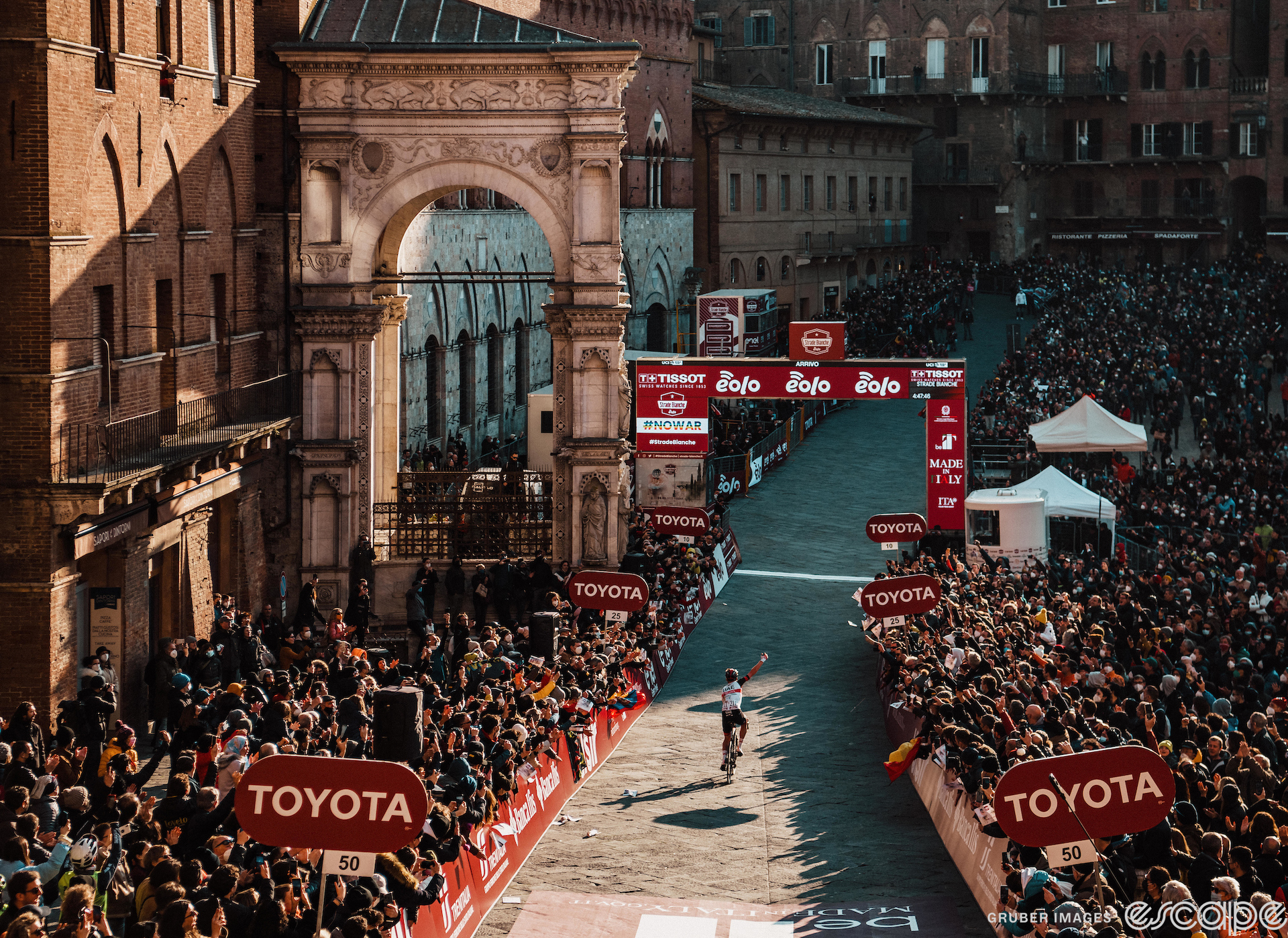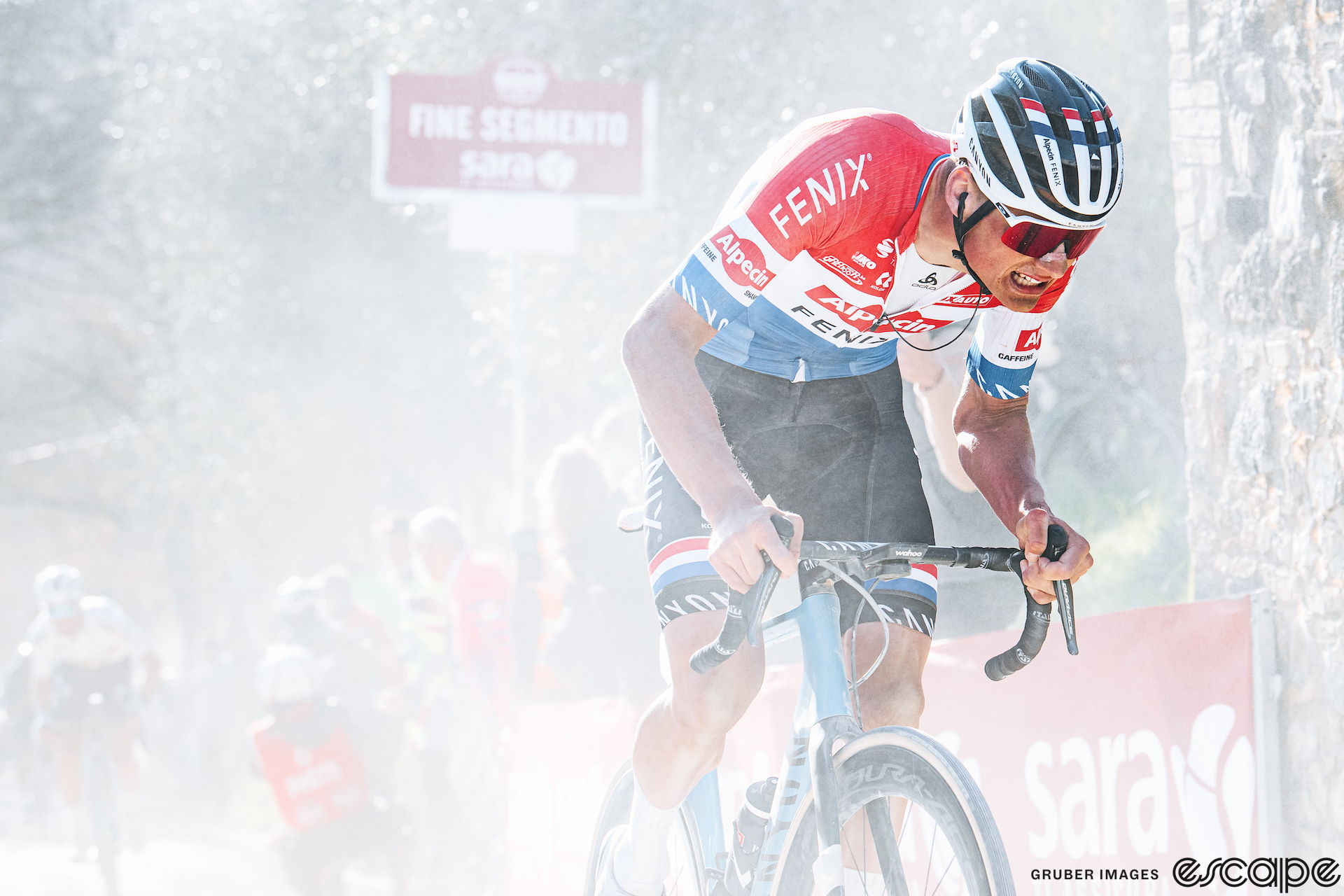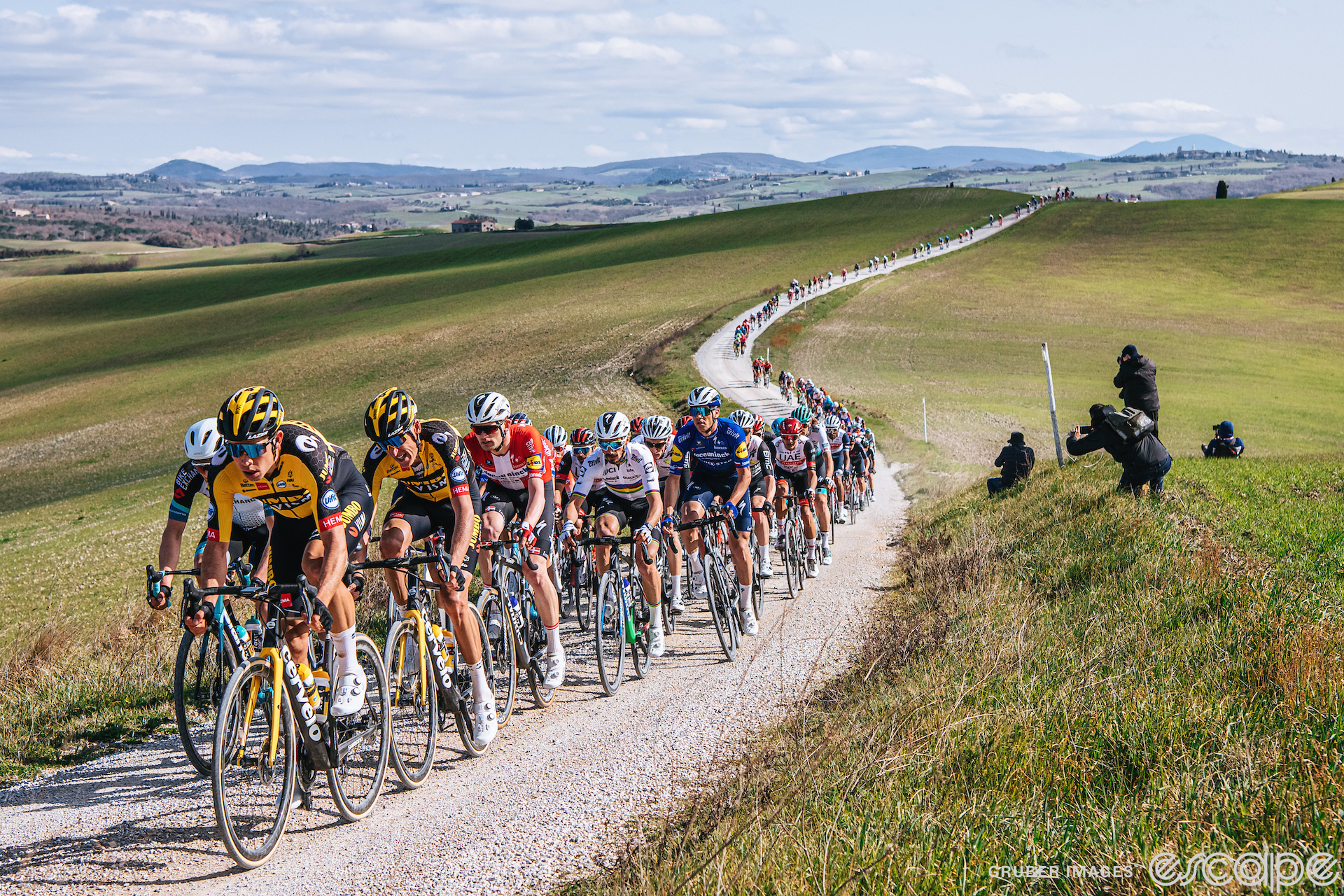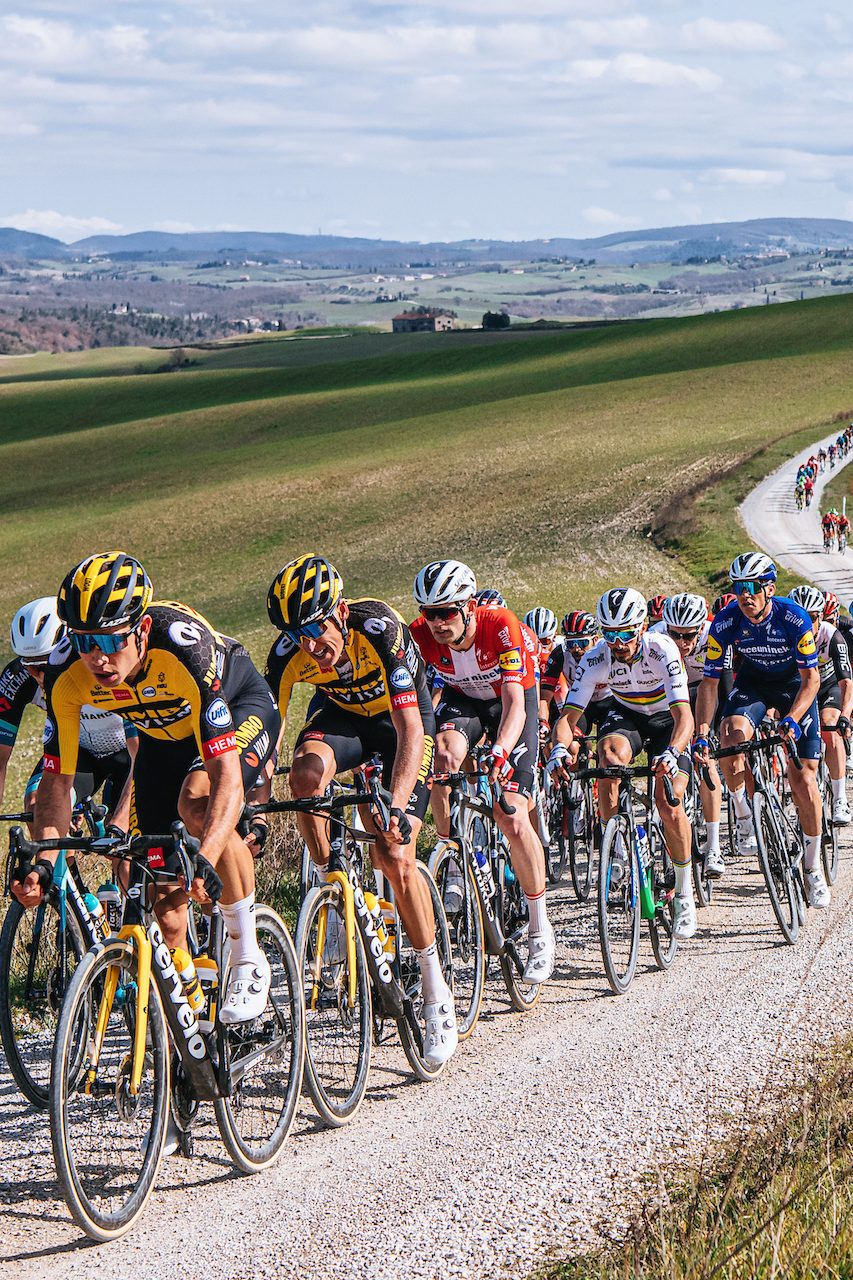Ah, early March. It’s Fool’s Spring in parts of the Northern Hemisphere (soon to be followed by Second Winter), the crocus burst forth from their winter slumber, and there’s another round of discussion about whether Strade Bianche is or is not – or should be! – a Monument.
“It’s an amazing, beautiful race,” Fabian Cancellara told Escape Collective, and as the event’s only three-time winner, with seven more wins in Monuments, he should know (he’s back this year as team owner of Tudor Pro Cycling, in its first attempt at the race). Although relatively new, its setting and origin in the history-focused Eroica amateur event makes it feel far older; it’s “not just a race that came and popped up around the corner,” he says. “You say, ‘Hey, that looks like it could be a Monument race as well.’”
Two-time winner Michał Kwiatkowski agrees. The Ineos Grenadiers rider is backing defending champion Tom Pidcock on Saturday, and told Escape that Strade’s iconic course sets it apart from other races, noting “the finish line on the Piazza del Campo is probably the best finish line you can design.”
The latest chapter of the debate actually kicked off weeks ago when Philippe Gilbert, a man who also knows Strade, and Monuments, opined on the Website Formerly Known As Twitter that “it would be a big error” to make Strade Bianche a Monument.
Gilbert had some good, if arguable, points (would it really upset the universe’s natural order if Italy had a third Monument?), but we’re getting ahead of ourselves here a bit.
It’s a foundational tenet of logic that, to assess the validity of a proposition (Strade Bianche is/is not a Monument), everyone involved must be working from commonly understood premises. And when it comes to defining what is a Monument, there aren’t any; we just think there are.
Monument vs. monument
Well, there is a definition of sorts, but it’s circular: the five Monuments are Milan-San Remo, the Tour of Flanders, Paris-Roubaix, Liège-Bastogne-Liège, and Il Lombardia because those are the five Monuments.
But wait: Who decided these were the five Monuments? By what criteria?
The UCI is the organizing body of cycling, but the word “monument” appears nowhere in the 300-odd pages of its rules on road racing. “Grand Tour” by contrast, is found in multiple spots.
In prior years, the UCI’s rules limited the length of most road races to 250 km or less, with the Monuments granted a kind of dispensation, but the latest version of the rules says simply that, on the WorldTour, “distance [is] determined by the Professional Cycling Council.”
The only hint of special status for the five biggest one-day races comes in the UCI’s points structure. The Tour de France stands in its own category (1,300 points for the win), with the Giro d’Italia and Vuelta España offering 1,100 points to the winners, followed by the Monuments at 800. Other WorldTour events get progressively fewer points, and while Strade Bianche looms large in fans’ imaginations, the cold-eyed arbiters at the UCI have stuck it in the fifth of six points tiers, ahead of Omloop Het Nieuwsblad but behind the two Canadian Grands Prix, which are three years younger than Strade.

The first known use of the word “monument” to describe one of the five races was a headline in a 1949 edition of the French newspaper Ce Soir: “Paris-Roubaix ‘monument’ du cyclisme” (lower case, scare quotes original). Handy that the word means the same thing in French and English.
The author, Albert Baker d’Isy, was one of the most prominent journalists covering the sport and would go on to found the iconic journal Miroir du Cyclisme. But the term doesn’t seem to have gone from monument to Monument until the 1990s at the earliest, according to usage in journals like VeloNews.
As diverse as they are, there are some broad similarities to Monuments. For one thing, they’re all very old; the youngest – the Tour of Flanders – dates to 1913, and even with interruptions for war and other causes, they’ve each run well over 100 editions. Maybe in another 100 years things will look different but, right now, “the lack of history, you can’t change,” says Kwiatkowski of Strade’s situation.
They’re also very long, partly as a vestige of what were then-normal race distances prior to World War I. The shortest, Il Lombardia, was almost 240 km last year, while Milan-San Remo has regularly been around 300 km.
That length is accompanied by remarkable difficulty; at Milan-San Remo, the length is the difficulty. Flanders and Roubaix have their punishing cobbles. And despite a longest climb of 4.7 km, this year’s Liège-Bastogne-Liège has over 4,000 meters of elevation gain and Lombardia has even more, both similar to what a queen mountain stage in a Grand Tour would have.
But none of that really tells us what makes a Monument. As Cancellara points out, “Milano-Torino is one of the oldest bike races we have in cycling, but it’s not a Monument, right?” He’s correct; as historic as it is, the race just never quite captured the sport’s imagination in a monumental way.
Paris-Tours – first run in 1896 – was regularly 230-250 km as recently as a decade ago, but no longer has the same place of prominence it once did and its startlist has shifted accordingly. Strade Bianche, by contrast “has been won by the greatest riders, like all the big names,” Kwiatkowski notes. “You can’t call it a Monument because of the [lack of] history, but it is one of the biggest races in the calendar for me.”

Which raises the question: are the Monuments fixed in time? That we have these five, and only these five, as long as they exist? That’s probably most pertinent for Lombardia, which is the only one of the five that seems to strain to remind fans that it’s a Monument, perhaps due to its isolated place on the calendar and said calendar’s ever-expanding nature.
The furious finale of Milan-San Remo leads to the explosive violence of the Flanders and Roubaix cobbles, and even Liège feels like a kind of climax to the Classics season before attention shifts to stage racing. Lombardia, on the other hand, sits in October, a lonely denouement for an exhausted peloton looking fondly toward a too-short offseason.
A modern monument
So how then do we decide what is and is not a Monument?
Something else aligns the five races, of course: distinctiveness of character, originality. “They have this kind of mythical story about them,” notes Alexander Kristoff, winner of Milan-San Remo and the Tour of Flanders.
Milan-San Remo is all about anticipation – it is a culmination, as my colleague Kate Wagner so aptly put it last year. Flanders and Roubaix are defined mostly by their sheer brutality, along with – for Roubaix in particular – the cruel caprice that sees Wout van Aert with a gap on the Carrefour only to moments later be denied a chance for his first cobbled Monument victory by a flat tire. Gritty Liège has its relentless côtes. And Lombardia has its breathtaking Como vistas and of course, the climb past the chapel of the Madonna del Ghisallo, patron saint of cyclists.
That’s the kind of character that Cancellara and others see in Strade Bianche: like Roubaix or Flanders, a single photo, shorn of captions or any other context, can instantly tell you what race it is. You just know. Even in only its 18th year, Strade has an undefinable weight and depth that is inextricably tied to the terroir of its white gravel roads, “a surface that hasn’t existed before” in the sport, says Cancellara.
Are there other races like this, I ask Cancellara? He muses for a moment. Amstel Gold Race is beautiful, “but it’s not a Monument,” he says with declarative finality. Gent-Wevelgem is quite old, he notes (this year is its 86th edition), “a beautiful race as well, but it doesn’t …” he trails off before finishing simply, “I don’t know.”
With the course changes this year, there’s a sense that RCS, the organizers, are somehow aiming for Monument status, boosting the distance of the men’s race past 200 km and adding more gravel, which now makes up exactly a third of the race’s total length. Riders are split on how that will affect the race. Cancellara says that, in the past, “It’s a race that all kinds of different riders could win,” but that may not be the case anymore.

However, it’s also true that riders today have progressed even from Cancellara’s time. Neither Wout van Aert nor Mathieu van der Poel is on this year’s startlist, but if they were, could we say with confidence that the extra distance, gravel, and climbing would prevent either former winner – even at close to Cancellara’s size – from having a shot at another victory?
Races change. Riders change. The sport shifts over time. And the Monuments themselves are not, however we might wish them to be, immutable. “Modern cycling is a big fight between big riders now, and it doesn’t really matter if it’s [at] the race with the biggest history,” says Kwiatkowski.
So perhaps, thinks Cancellara, there’s room for something else. “Flanders is definitely a Monument and will stay a Monument,” he says. “There needs to be history in the sport.
“But maybe there is space for something like a modern monument,” a nod to the fact that the sport must grow and evolve, that it should embrace change and honor the past without becoming stuck in it. A way to acknowledge that a race like Strade Bianche is not less, just that it is different, and unique, and should be celebrated for that.
Did we do a good job with this story?


